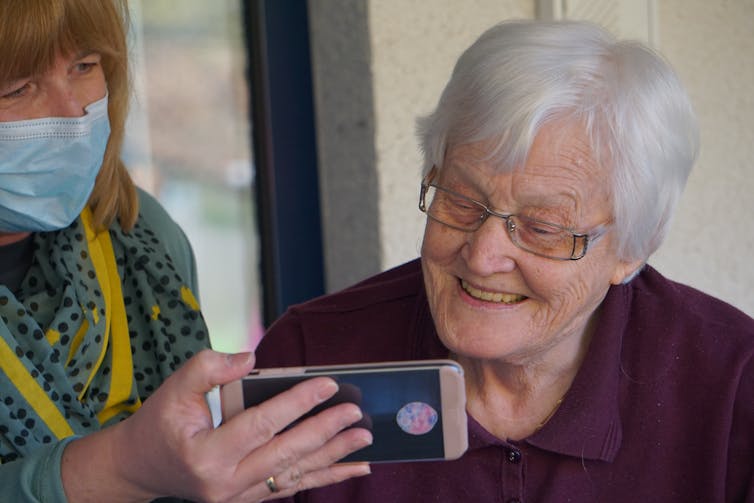A mammoth effort will be needed to increase staffing across the aged care sector.

In his election victory speech, Prime Minister Anthony Albanese pledged to “fix the crisis in aged care”.
One of the biggest challenges facing incoming aged care ministers Mark Butler and Anika Wells is addressing widespread staffing shortages.
But our latest research shows a mammoth effort will be needed to increase staffing across the sector. Only a fraction of aged care homes currently have staffing levels above new minimum ratios that will be mandatory from October next year.
What has Labor promised?
Following the revelations during the aged care royal commission and thousands of COVID deaths in aged care, much of the public’s attention has focused on the lack of adequate staffing.
Last year the Coalition committed to mandatory ratios in residential aged care homes, so that by 2023:
- residents will receive, on average, at least 200 minutes of total care per day
- at least 40 minutes of that care will be provided by an registered nurse
- a registered will be on-site for morning and afternoon shifts each day.
Labor has since promised to lift staffing levels by implementing more ambitious minimum staffing ratios, so that by 2024:
- residents will receive, on average, at least 215 minutes of total care per day
- at least 44 minutes of total care will be provided by registered nurses
- a registered nurse will be on-site 24 hours a day, seven days a week.
What we found
Our recent report, based on a survey of 1,192 residential aged care homes and 55,821 home care packages, shows providers are struggling to improve staffing levels.
In the past year, total care time grew by only 1.9% across surveyed residential aged care homes.
The average care time (178 minutes per resident per day) is well short of the mandatory thresholds of both the previous and incoming governments.
To reach the 2023 target (set by the previous government) of 200 minutes, providers will have to increase total care staffing by roughly 12.4% by October next year.
When we considered the staffing requirements in combination, we found only 5% of surveyed homes had staffing levels that exceeded all three of the incoming 2023 ratios, and only 3% were above the 2024 thresholds proposed by Labor.
Concerningly, little has changed since our analysis of 2019 staffing levels.
In home care, care staffing time has continued to fall. On average, home care package clients received about 33 minutes of care per day, which is 32% lower than five years ago.
A perfect storm
Staffing shortages have been an issue in aged care for years. Providers have struggled to attract and retain workers, having to compete with other health and disability sectors that offer higher comparative award rates.
Workers are also put off by poor working conditions, limited career pathways and negative perceptions of the industry.
These long-term issues have have been compounded by COVID which severely disrupted the supply of aged care workers. Border lockdowns closed migration pathways, outbreaks forced staff into self-isolation, and health-care workers were diverted towards the pandemic response.
Working during the pandemic also placed substantial pressure on existing staff. A recent survey by the Australian Nursing and Midwifery Federation found 21% of aged care staff reported planning to leave their position within the next 12 months. A further 37% said they planned to quit the sector within the next one to five years.

Working in aged care during the pandemic has been tough. Georg Arthur Pflueger/Unsplash
The final pressure point is the rapid expansion of home care services. Compared to June 2017, there are 126,000 more people receiving support through home care packages.
Increasing the availability of home care is critical to clearing the current waiting list and enabling more senior Australians to receive support in their own homes.
However, the release of more packages has intensified competition for workers, with reports that providers are unable fill shifts to meet demand.
This perfect storm is unlikely to ease soon. In the next year, a further 57,876 new home care packages will be assigned to senior Australians, at the same time as residential care providers try to lift their staffing to meet the minimum requirements.
So what needs to change?
While setting minimum staffing requirements is a crucial first step, it will not improve staffing unless the more fundamental issues in attracting and retaining aged care workers are addressed.
One such issue is workers’ pay. It’s no surprise that on her first day as minister, Wells began work on the government’s submission to the Fair Work Commission in support of workers claim for a 25% increase in the award.
Another issue is the need for more training opportunities for aged care nurses in Australia.
Although border openings may allow for skilled migration to resume, COVID has increased demand for workers in all countries resulting in a global shortage of nurses.
Finally, working conditions need to improve to stop the high levels of staff turnover across the sector. Figures from the 2020 Aged Care Workforce Census reveal an annual attrition rate of 29%, meaning around one in three aged care workers leave their job each year.
Without meaningful improvements to working conditions in rostering, shift lengths and travel times, shortages of these vital workers who deliver care and support to senior Australians will persist.![]()
Nicole Sutton, Senior Lecturer in Accounting, University of Technology Sydney and Nelson Ma, Senior Lecturer, University of Technology Sydney
This article is republished from The Conversation under a Creative Commons license. Read the original article.

